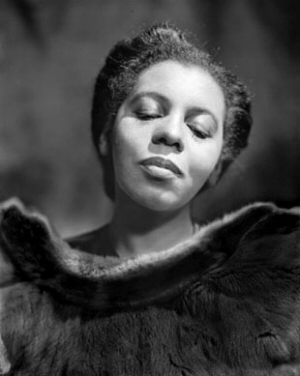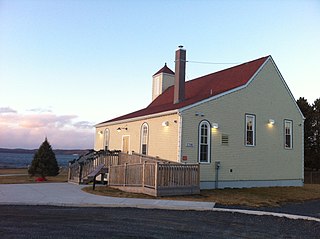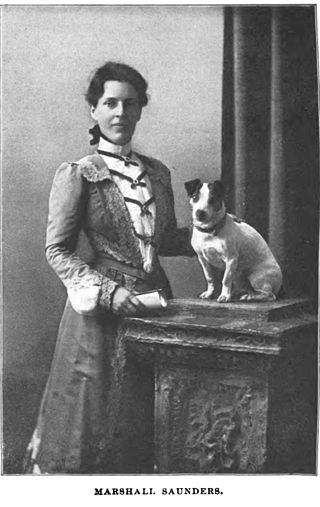
Nova Scotia is one of the thirteen provinces and territories of Canada. It is one of the three Maritime provinces and one of the four Atlantic provinces. Nova Scotia is Latin for "New Scotland".

Portia May White was a Canadian contralto, known for becoming the first Black Canadian concert singer to achieve international fame. Growing up as part of her father's church choir in Halifax, Nova Scotia, White competed in local singing competitions as a teenager and later trained at the Halifax Conservatory of Music. In 1941 and 1944, she made her national and international debuts as a singer, receiving critical acclaim for her performances of both classical European music and African-American spirituals. White later completed tours throughout Europe, the Caribbean, and Central and South America.

The Halifax Forum is an arena and multi-purpose facility in Halifax, Nova Scotia. Its uses include sporting events, bingo, ice skating, concerts and markets. It was built in 1927 on the site of the former Nova Scotia Provincial Exhibition which was badly damaged by the Halifax explosion in 1917. It opened on 26 December 1927 and incorporated the first artificial ice surface east of Montreal. It is the second biggest arena in Nova Scotia, and the fifth biggest in Atlantic Canada. The building was added to the Canadian Register of Historic Places in 2003.

Africville was a small community of predominantly African Nova Scotians located in Halifax, Nova Scotia, Canada. It developed on the southern shore of Bedford Basin and existed from the early 1800s to the 1960s. From 1970 to the present, a protest has occupied space on the grounds. The government has recognized it as a commemorative site and established a museum here. The community has become an important symbol of Black Canadian identity, as an example of the "urban renewal" trend of the 1960s that razed similarly racialized neighbourhoods across Canada, and the struggle against racism.

Anne of Green Gables: The Continuing Story is a 2000 miniseries television film, and the third installment in a series of four films. The film was highly anticipated among fans of Anne of Green Gables, and was the most controversial and heavily criticized of the three film adaptations written and produced by Kevin Sullivan.

Province House in Halifax is where the Nova Scotia legislative assembly, known officially as the Nova Scotia House of Assembly, has met every year since 1819, making it the longest serving legislative building in Canada. The building is Canada's oldest house of government. Standing three storeys tall, the structure is considered one of the finest examples of Palladian architecture in North America.
The Mayflower Curling Club, was established in 1905. Since 1962 the club has been located at 3000 Monaghan Drive in Nova Scotia's Halifax Regional Municipality.

St. Matthew's United Church is a United Church of Canada church in downtown Halifax, Nova Scotia. The church was founded at the same time as the original colony in 1749 as a home for the various groups of dissenting Protestants who were from New England and who did not follow the Church of England. It originally met Sunday afternoons in St. Paul's Church, the Church of England building completed in 1750. The church got its own home in 1754 when a church was constructed at Hollis and Prince streets. This building was destroyed by fire in 1857, and a new church was built at the current location at 1479 Barrington Street, land parcelled off of the Black-Binney House estate by Bishop Hibbert Binney. The church used the Old Burying Ground.

Margaret Marshall Saunders CBE was a prolific Canadian writer of children's stories and romance novels, a lecturer, and an animal rights advocate. She was an active member of the Local Council of Women of Halifax.

St. Paul's Church is an evangelical Anglican church in downtown Halifax, Nova Scotia, within the Diocese of Nova Scotia and Prince Edward Island of the Anglican Church of Canada. It is located at the south end of the Grand Parade, an open square in downtown Halifax with Halifax City Hall at the northern end.

The Halifax Court House is a historic building in downtown Halifax, Nova Scotia. Its main section was completed in 1863, with the east wing, built in 1930, being the newest portion. The Italian renaissance style building was designed by William Thomas, a Toronto architect who created prominent structures across Canada, and built by George Lang.

The Halifax Armoury is a military structure in central Halifax, Nova Scotia, Canada. The armoury is the home base of The Princess Louise Fusiliers, and several cadet units.

Lawrencetown is a Canadian rural community in the Halifax Regional Municipality in Nova Scotia, Canada. The settlement was established during the eve of Father Le Loutre's War and at the beginning of the French and Indian War.

The Raid on Lunenburg occurred during the French and Indian War when Mi'kmaq and Maliseet fighters attacked a British settlement at Lunenburg, Nova Scotia on May 8, 1756. The native militia raided two islands on the northern outskirts of the fortified Township of Lunenburg, Rous Island, and Payzant Island. According to French reports, the Raiding party killed twenty settlers and took five prisoners. This raid was the first of nine the Natives and Acadians would conduct against the peninsula over a three-year period during the war. The Wabanaki Confederacy took John Payzant and Lewis Payzant prisoner, both of whom left written account of their experiences.

The Grand Parade is an historic military parade square dating from the founding of Halifax in 1749. At the north end of the Grand Parade is the Halifax City Hall, the seat of municipal government in Nova Scotia's Halifax Regional Municipality. At the south end is St. Paul's Church. In the middle of Grand Parade is the cenotaph built originally to commemorate the soldiers who served in World War I.

Nova Scotia is a Canadian province located in Canada's Maritimes. The region was initially occupied by Mi'kmaq. The colonial history of Nova Scotia includes the present-day Canadian Maritime provinces and the northern part of Maine, all of which were at one time part of Nova Scotia. In 1763 Cape Breton Island and St. John's Island became part of Nova Scotia. In 1769, St. John's Island became a separate colony. Nova Scotia included present-day New Brunswick until that province was established in 1784. During the first 150 years of European settlement, the colony was primarily made up of Catholic Acadians, Maliseet and Mi'kmaq. During the latter seventy-five years of this time period, there were six colonial wars that took place in Nova Scotia. After agreeing to several peace treaties, this long period of warfare ended with the Halifax Treaties (1761) and two years later when the British defeated the French in North America (1763). During these wars, Acadians, Mi'kmaq and Maliseet from the region fought to protect the border of Acadia from New England. They fought the war on two fronts: the southern border of Acadia, which New France defined as the Kennebec River in southern Maine. The other front was in Nova Scotia and involved preventing New Englanders from taking the capital of Acadia, Port Royal, establishing themselves at Canso.

The Halifax School for the Deaf was an institution in Halifax, Nova Scotia, Canada, which opened on 4 August 1856. It was the first school of the deaf in Atlantic Canada. There was later a dispute over who the true founder was, William Gray (1806-1881), a deaf Scottish immigrant who was the first teacher in the back room of a house in Argyle Street, or George Tait (1828-1904), another deaf Scot, who claimed to have been the driving force behind the establishment of the school. Gray was sacked in 1870 for being intoxicated and for threatening pupils with violence.
Mary Eliza Herbert (1829–1872) was a Canadian publisher and poet. She published and managed the Mayflower, or Ladies' Acadian Newspaper in 1851, making her the first female newspaper publisher in Nova Scotia.
Lucy Anne (Rogers) Butler, also known as Annie H. (Rogers) Butler, was a writer and social justice advocate. Her personal diary, which chronicled her travels with Captain John Kendrick Butler during the early years of their marriage, documents the lifestyle of Canadian mariners and their wives and widows during the mid to late 19th century.
Robbie MacNeill is a guitarist and singer-songwriter who was born in Halifax, Nova Scotia. He attended Queen Elizabeth High School and studied engineering at Dalhousie University for two years, before moving to Toronto to work as a surveyor in 1964. In the late sixties and early 70's he arranged, conducted and performed with The Privateers, billed as 'Eastern Canada's Only Professional Fork Chorus'. He went on to work with a number of other artists, and released his own album 'Pieces' in 1984.
















